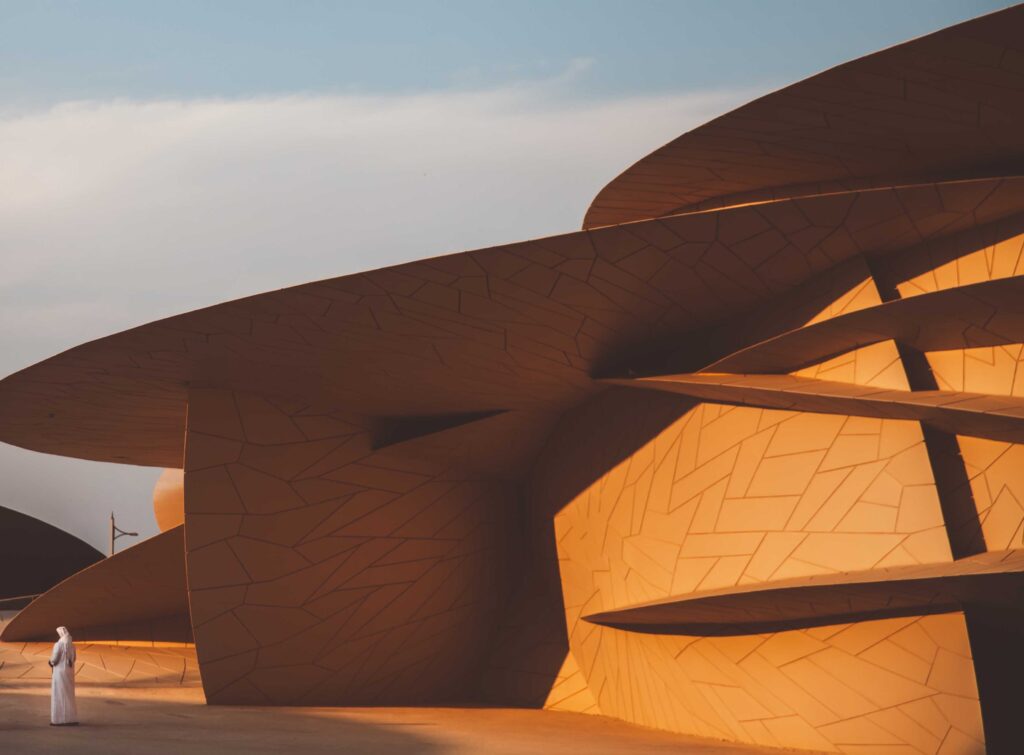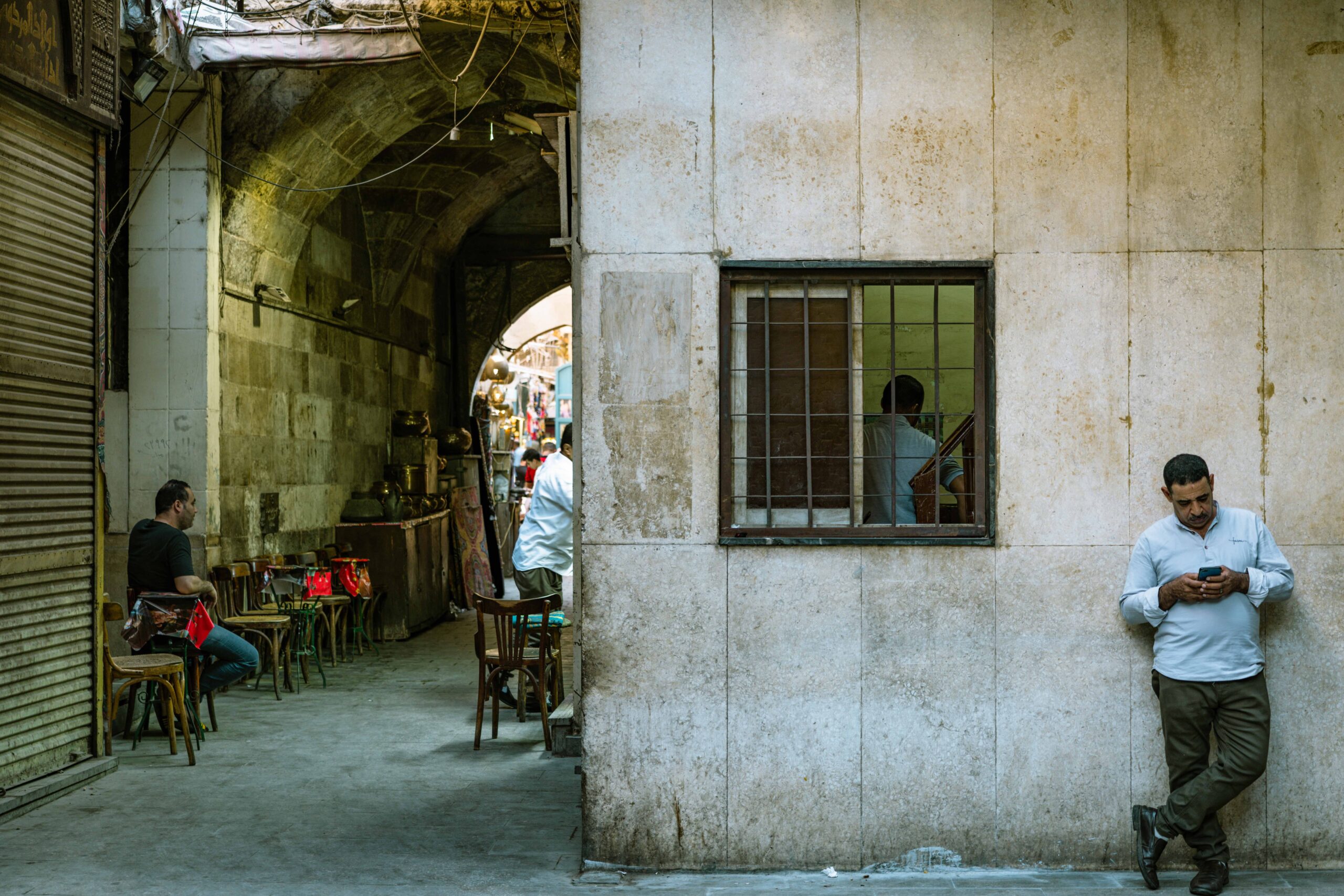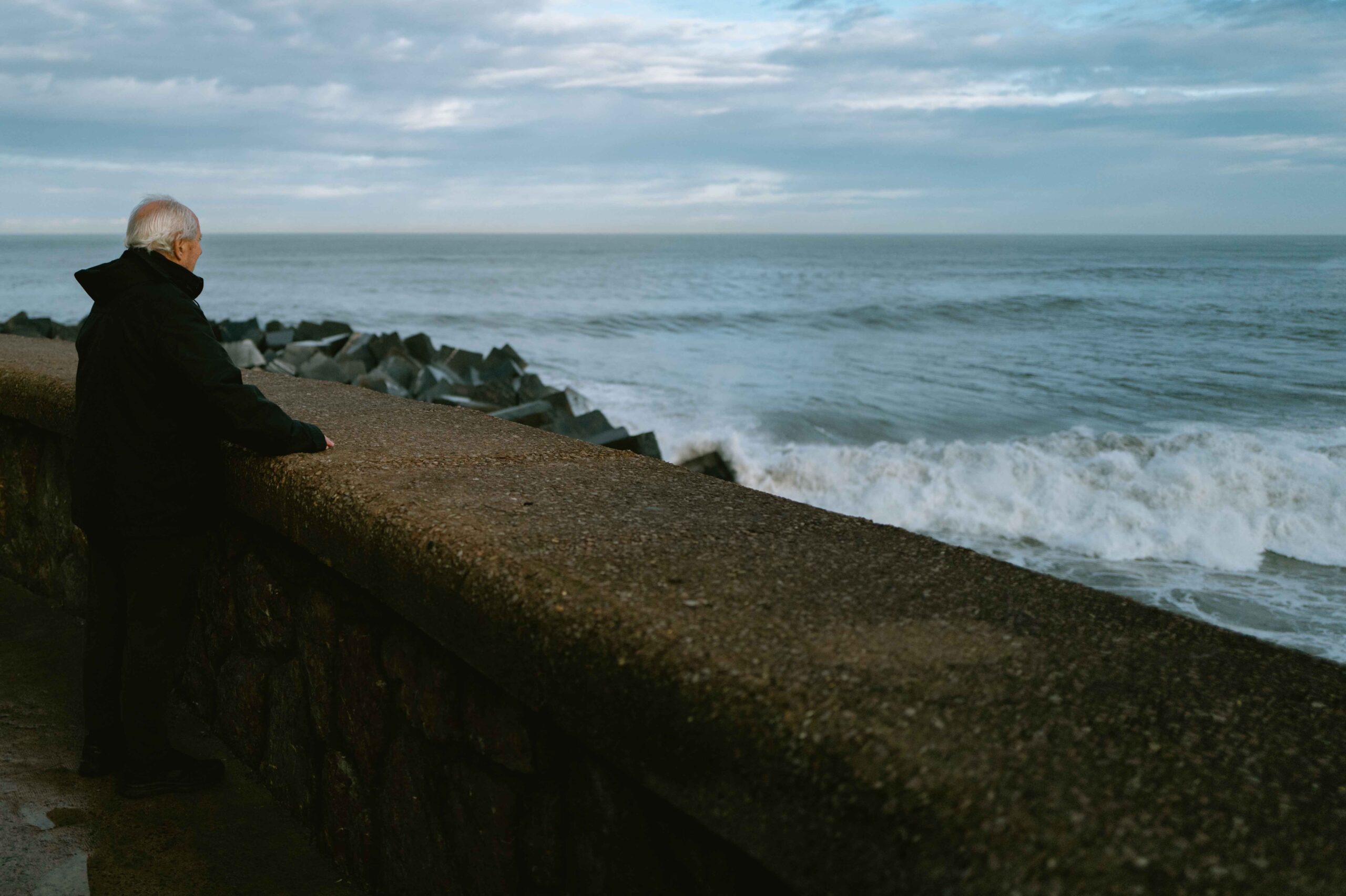I remember vividly a scene from the opening ceremony of the 2006 Doha Asian Games:
All at once, the stadium lights dimmed. Hundreds of Arab women dancers, draped in black veils and carrying enormous palm leaves, stepped barefoot into the center of the arena. Their faces were solemn, their eyes glimmering with tears, as though awaiting some momentous ritual. Behind them, on the ground, special-effect lighting gradually flickered on, bathing the stage in a bluish-white glow that made it seem as if they were wading into the sea. Then, to the measured cadence of the on-site chanting, the dancers began to use their palm leaves to beat back the crashing waves conjured by the lights. Striking in unison, they raised their voices in song:
The white ocean, how the wild waves surge,
As graceful as dancing snowflakes in the wind.
In my dreamlike vision, I glimpse a sail on the distant horizon.
On that vessel are valiant sailors—
My guiding stars in pursuit.
The moon arcs overhead, all creation falls silent;
A red anchor, a red buoy, beckoning peace and calm.
The waves churn, a gentle breeze drifts in,
And my beloved lies hidden in the depths below.
Their plaintive melody, fragile like a candle flickering in the wind, stood in stark contrast to the otherwise jubilant atmosphere of the ceremony. At that moment, the crowd fell completely silent. Only the dancers’ lamenting cries, the roar of the imagined surf, and the sharp crack of palm leaves striking the ground broke the hush.
Watching the broadcast from home, I could not begin to fathom the significance of this grand spectacle. Bewilderment and awe were all I felt, and I recall only one sentence from the commentator, spoken after a long silence: “They are mourning their husbands who perished at sea while diving for pearls.”
That was my first impression of Qatar: a sports event, weeping women, men lost to pearl diving, and a prince of the Al Thani family galloping on horseback to light the flame. I knew next to nothing about the place. In the media coverage I had read, “Qatar” usually appeared only as a byword for wealth, oil, and Al Jazeera. Like the other countries tucked away in the Persian Gulf, it was discreet, enigmatic, and indistinct.
So when I arrived in Qatar for the first time on a work trip thirteen years after the Doha Asian Games, I felt an old thrill of travel and discovery reawakening within me. My fragmented memories of the country meant I had no set expectations. Few travelers venture here, and there was little in the way of shared travel experiences to guide me. By sheer coincidence, I now had the chance to explore my own personal bond with this unfamiliar land, rather than continually verify the observations of others.
Seated in the vehicle provided by my hosts, I traveled from the airport into the city. Along the way, Xiaoxin, a Chinese colleague, patiently explained the schedule for the coming days. “In Qatar, there’s no such thing as an accident,” she said with a smile, pointing to the itinerary. “But you’ll be surrounded by surprises at every turn.”
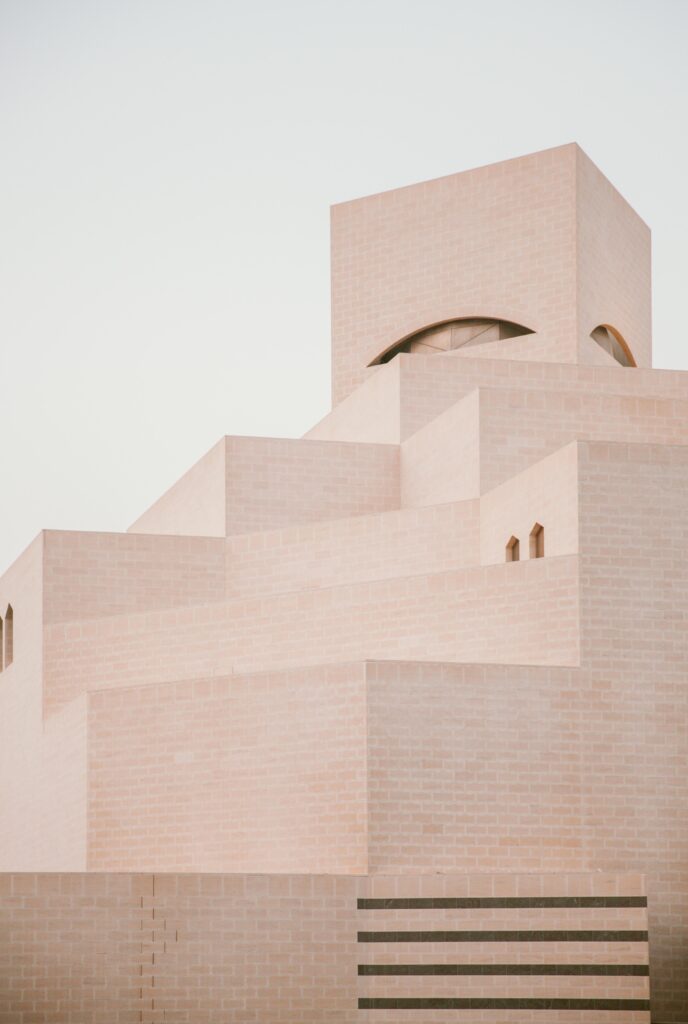
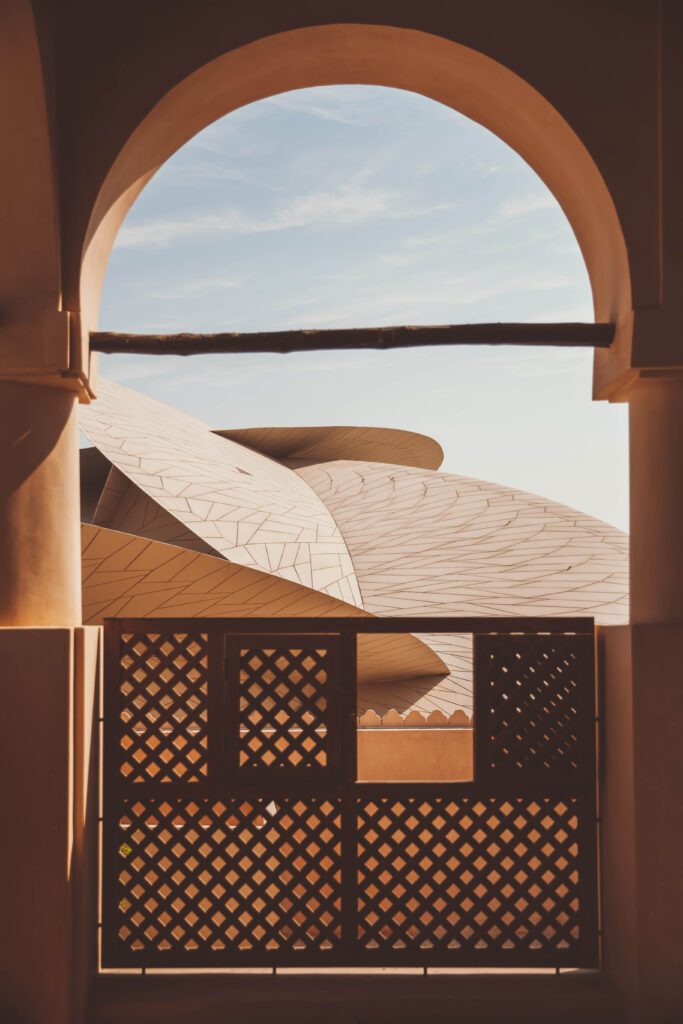
Outside the car window, Doha on a Monday morning felt crowded and hectic. Cars and motorcycles wove across the roads, vying for speed. The piercing blare of horns and the low rumble of engines blended with the city’s resonant call to prayer, like a symphony heralding our arrival. In every Arab country I’ve visited, I’ve witnessed this familiar roadside tableau: people unleashing a boundless sense of freedom in traffic, much as their nomadic forebears once galloped across vast grasslands. Flocks of pigeons rose into the air, churning up dust like drifting snow in broad daylight. Through the haze of the Persian Gulf, clusters of low, milky-white residential buildings shimmered under the sun like candles in flame. The deep blue sky I’d seen when flying over the Gulf now turned a pale yellow.
“That’s dust from the western desert,” Xiaoxin explained, noticing my puzzled look. “Every morning, the west wind carries a load of sand into the city.” Though the Qatari peninsula is surrounded on three sides by the sea, almost all its land is desert. Desert and sea alike possess a vastness that conjures both solitude and a certain softness. I couldn’t help but wonder if this characteristic also ran through the Qatari spirit.
As we neared the city, a crescent-shaped bay emerged before my eyes. Along the long, winding shoreline, the low suburban buildings suddenly gave way to a series of towering skyscrapers of striking design. Through the drifting sand, Doha’s modern waterfront skyline flickered like a mirage in the desert—grand, but at this moment, more unreal than awe-inspiring. It was difficult to imagine that just half a century ago, this had been a dusty little fishing village.
Besides the tall buildings, there was a surprising abundance of greenery—rare in a desert land. Swathes of yellow and green met where sky and sea converged. For travelers like me, these trees offered a welcome visual buffer between the ocean, the city, and the desert. For the Qataris who live here, these trees stand as symbols of wealth and status. “In Qatar, the more trees you have, the higher your social standing,” Xiaoxin said, pointing toward the shoreline. This area is modern Doha’s landmark and the first impression most visitors get of Qatar.
By now, the midday sun blazed overhead, and the trees drooped as though drowsy—reminding me of my own fatigue after a long flight. The daytime heat felt like a sealed kiln. I glanced at the car’s display screen: the outside temperature was 48 degrees Celsius.
After checking into a hotel near the bay, I woke to find evening had arrived. The scorching heat of the day had eased, and I stepped onto the Corniche for a stroll, savoring the gentle comfort of the Persian Gulf breeze on my face. Turning toward the setting sun, I saw the waters of the Gulf tinged with a rose-lavender hue in the interplay of mist and drifting sand. The sunlight slipped away into the brightening stars, and the city’s clamor softened to something like the melody of an oud. Doha’s residents, who had sheltered indoors during the day, now spilled onto the waterfront and into the city’s alleys. Gazing at the bay, I saw people piloting single-masted dhows, chasing the last gleams of daylight across the rolling waves; couples in robes strolled side by side with a gentle, slightly formal sweetness; children ran and played, still free from the labels of religion and lineage—pure and carefree.
Near the Museum of Islamic Art, I came upon a large concrete sculpture: a giant clam shell spread wide, cradling a perfect pearl within. This vivid emblem struck me like a bolt of lightning, awakening a memory from thirteen years earlier and the haunting commentary from that silent moment: “Husbands lost at sea while diving for pearls.” Suddenly, the scene before me and the one in my memory interlaced like tangled vines, twisting into a powerful question: “What does the pearl mean to Qatar?”
“It used to be Qatar’s only source of livelihood,” Xiaoxin answered nonchalantly. She had passed this sculpture countless times and grown used to explaining the story of Qatar’s pearls.
“I know Qatar is wealthy because of oil, but I’ve barely heard about its pearls,” I said in surprise.
“That’s because from around the 1920s onward, the pearl-diving industry in Qatar nearly vanished.”
“Why did it disappear?”
“They discovered oil, and cultured pearls became more affordable.”
“Can one still find any trace of the pearl industry in Qatar?”
“You can, but very little remains.”
Following Xiaoxin’s lead, I left the sea behind and walked toward the nearby flow of people—Souq Waqif. As the oldest Arab marketplace in Qatar, Souq Waqif reflects how Doha’s modern exterior still preserves its historical memory and cultural heritage. We threaded our way through the bustling crowd, as though we had slipped into the pages of One Thousand and One Nights. A wide pedestrian thoroughfare runs from one end of the market to the other, lined on both sides with tightly packed handicraft stalls selling Arabian glass lamps, curved daggers, textiles, ceramic bowls, Indian bracelets, animal skins, and all manner of spices—items that once traveled along the ancient Silk Road. In front of one stall, a bracelet maker in traditional Indian attire sat on the ground, little hammer in hand, polishing a silver piece. The rhythmic clang of metal echoed like a greeting shared between Arab and Indian merchants on the rolling waves of the Persian Gulf. Behind the stalls, labyrinthine alleys stretch out in a web, paved with stone and flanked by walls of sandy-hued plaster, carved with octagonal latticework. Winding and twisting, these alleyways form a vast trading network.
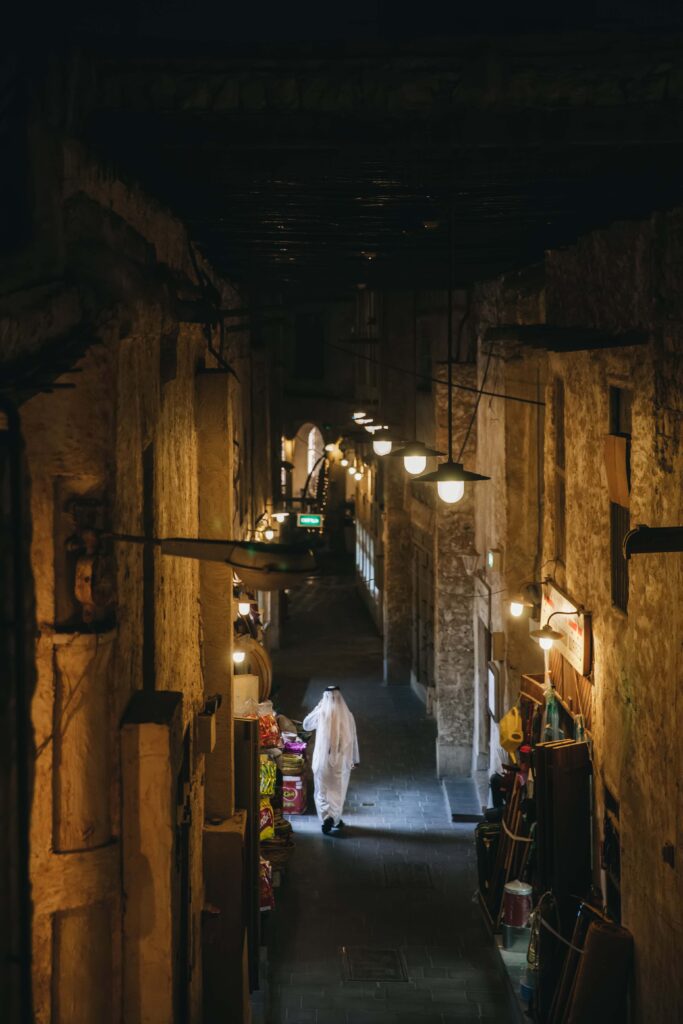
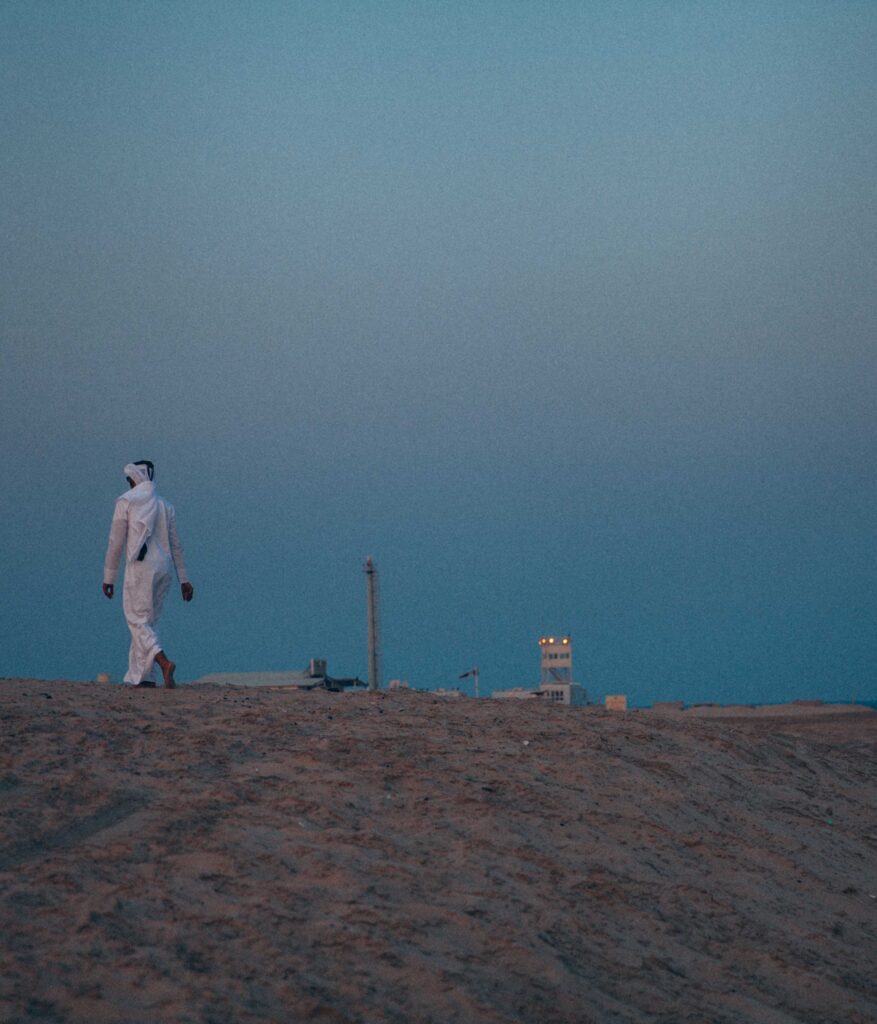

We drifted into one of the narrow lanes. Two young men in white robes brushed past me, each with a falcon perched on his wrist—a prized symbol of wealth for Qatari men. In the majlis rooms along the street, men sat chatting, smoking shisha, and playing board games, while a young woman slipped quietly through the haze of smoke. Her features were delicate, her hair lifting gently in the breeze. Compared to other Islamic countries, women in Qatar have more freedom in how they dress. They can choose to show their hair in public and reveal a confident smile. As for the artisans working in the shops, they seemed unconcerned with drawing in customers from the passing crowd. Immersed in their craft, they silently chiseled and carved inside, leaving their finished works—ouds, animal specimens, sand art bottles—casually displayed outdoors.
Pressing on through the crowd, we came to a stop near the Falcon Hospital. Behind Xiaoxin stood a small shop, so modest that even by Souq Waqif standards, it blended almost invisibly into its surroundings.
Yet the moment I stepped inside, a bright flash—like a camera’s strobe—momentarily dazzled me. Arrayed before me were rows of pearl ornaments, sparkling so brilliantly under the lights that they nearly overwhelmed my vision. And there was something uncannily familiar about the shopkeeper’s face.
“You probably saw him on your flight to Doha,” Xiaoxin suggested, trying to jog my memory.
“Ah, of course! You’re the face of the airline’s Doha promotional video!”
The shopkeeper looked up and gave a slight smile of confirmation, then returned his gaze to the pearl necklace in his hands. Like most merchants here, he was fully absorbed in his craft. His full name was Saad Ismail Al Jassem, and his pearl shop—unbranded and steeped in local tradition—was a favorite among Doha’s residents. He also held a remarkable distinction: he was officially recognized as the last living pearl diver in Qatar.
Like many Qataris, Saad’s ancestors were Bedouin nomads who once roamed the vast inland deserts. In that harsh emptiness, they soon learned to pin their hopes on the wider world of the sea not far away. They set sail, and when they discovered the ocean’s pearls, they took their first steps onto the global stage. Arab traders carried pearls to Mesopotamia, on to the Red and Mediterranean Seas, and across the Indian Ocean to East Asia. This pearl-trading route spanned both the overland and maritime Silk Roads of antiquity. I recalled reading in the Weilue’s “Account of Daqin” that Daqin (the Near East under the Roman Empire) had vassal states “Qielan and Sifu, straight south are rocky hills; beyond those hills lies the sea, which produces coral and pearls.” It further described how Daqin traded pearls at sea with the Parthian realms (in ancient Persia)—a clear reference to pearl diving and commerce in the waters of the Persian Gulf, including Qatar.
Profiting from pearls, the Bedouin gradually shifted from desert guardians following water and pasture to settled communities along the coast. Yet between the 1920s and 1940s, as oil and natural gas became Qatar’s main engines of swift economic ascent—and with the rapid rise of global cultured pearl technology—international pearl prices collapsed. An industry that had thrived in Qatari waters for nearly four millennia slowly disappeared beneath the blue waves of the Persian Gulf.
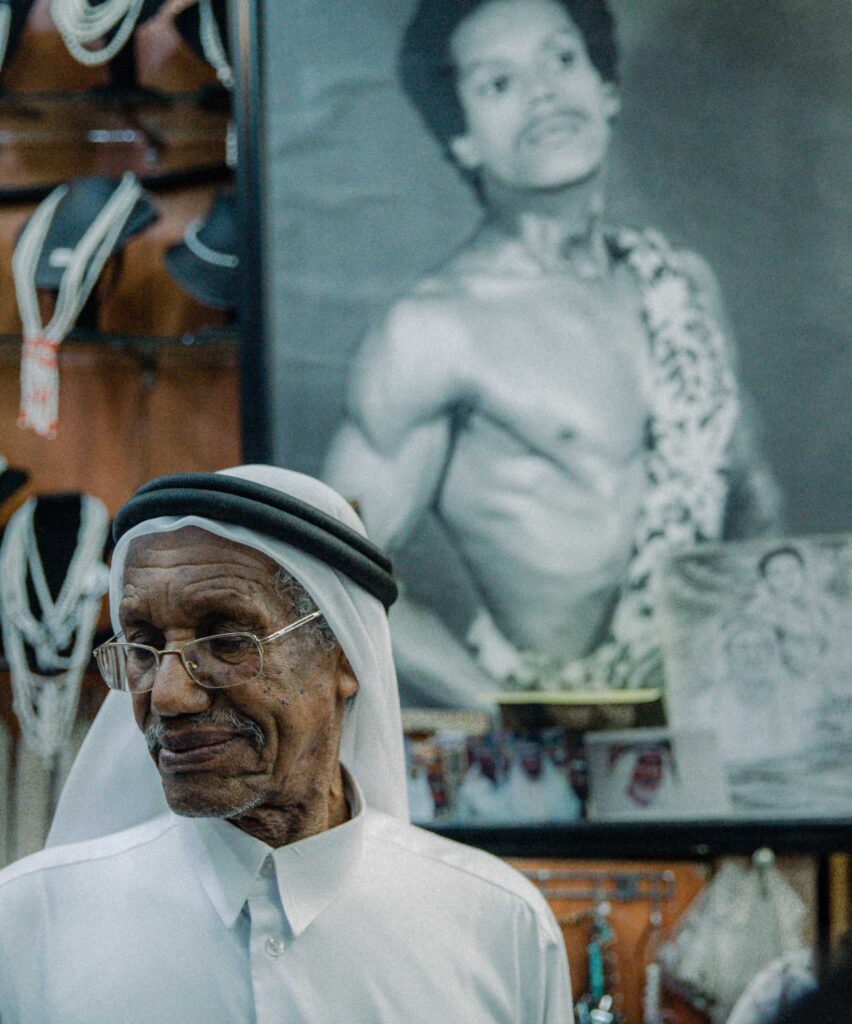
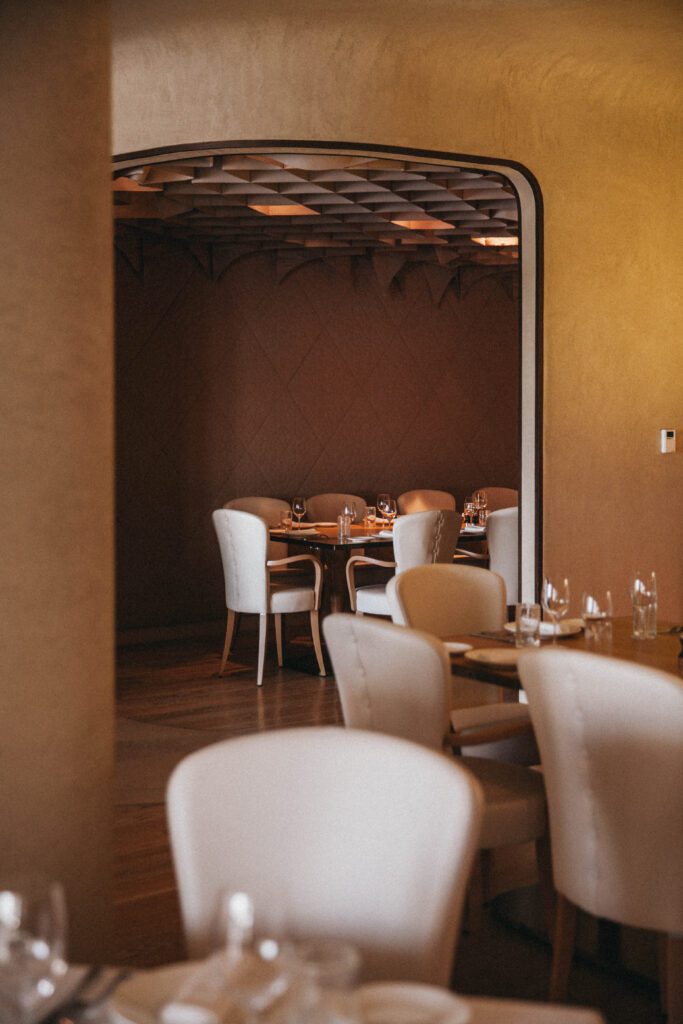
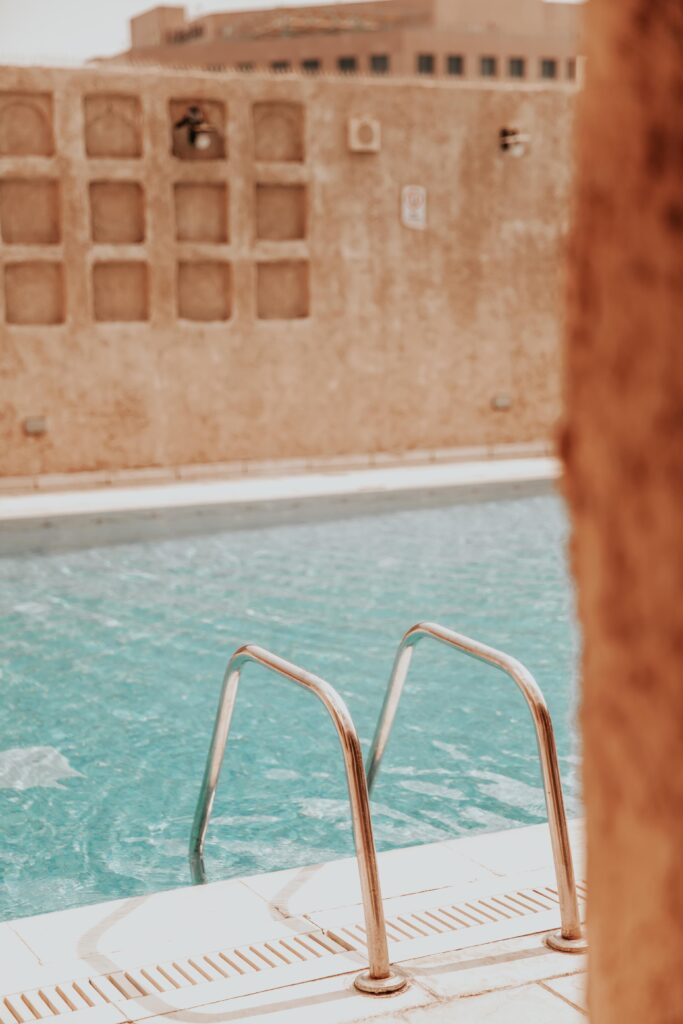
I casually picked up a strand of pearl necklace lying beside me. Each pearl was perfectly round and flawlessly white—like the morning raindrops dotting fresh lotus leaves in Yuan Haowen’s verses. Such pristine beauty could only belong to cultured pearls of natural origin. Each pearl gave off a faint glow, gentle and understated. In their reflection, I could glimpse my own blurred silhouette, and I imagined seeing the face of the worker who had first placed the seed within the oyster.
“Are these pearls from China?” I asked.
“Yes, they’re from China.” A flicker of surprise passed over Saad’s otherwise calm face.
“My hometown also produces a lot of pearls. Europe and the Middle East are their main export markets.”
Saad set down the necklace in his hand and took out a few single pearls from a drawer beneath the counter—his own treasured wild pearls. “These pearls,” he said, “along with most of the jewelry in the shop, come from China.”
I learned that they were sourced from the Yangtze River Basin—particularly Zhejiang, Hubei, and Jiangsu provinces. Once harvested, the cultured pearls are sent to Zhuji in Zhejiang, the major pearl-trading hub of East China.
I stood there, quietly gazing at the casually yet carefully arranged pearl ornaments before me, my thoughts jumping about like loose pearls rolling across a tabletop.
In my memory, the Qingming Festival of childhood was always damp and chilly in the early spring of Jiangnan. The holiday isn’t solely about honoring ancestors; after finishing the harvest of fresh bamboo shoots, the women of the village would gather in the ancestral hall to plant pearls. That ancestral hall is located in the countryside of my hometown—Jinhua in Zhejiang Province. Known as the Chen Family Hall, it features an open-air courtyard surrounded by white walls and black-tiled roofs and has long been a communal gathering place.
On its south-facing side stands a raised stage of about ten square meters. Its sturdy camphor-wood floor bears the light footprints of a century’s worth of performances. Every Spring Festival, a few Wu opera plays are performed on that stage, shaping my early understanding of human relationships and the boundaries of the world. Set into the ceiling above the stage was a circular jade-glass lamp, which glowed a soft yellow in the sunlight, like a giant pearl. No one in the village knew its origins. Whenever asked, the elders would wave their hands dismissively and say, “It’s always been there.” Today, that jade-glass lamp has been taken down and placed under official protection as a cultural relic, leaving behind a dark gray circle of emptiness.
On the days when pearls were planted, villagers would fill the courtyard with rows of long wooden benches. In front of each bench lay a shallow, round bamboo basket holding a small porcelain bowl filled with spherical seeds about two millimeters in diameter. Stacked around the bowl were palm-sized pearl oysters, forming a little hill. Modern pearl cultivation requires inserting these seeds into the oysters by hand. Once a foreign particle is introduced, the mollusk secretes nacre that wraps the seed layer by layer, eventually forming a pearl. The oyster may remain in the water for several years—or even up to twenty—while the nacre slowly becomes a gem.
Working in pairs, one person would use a small wooden wedge to gently pry open the shell, while the other would swiftly place four or five seeds inside with a pair of tweezers, then close the shell and place it in a nearby bucket of water. Their teamwork was so seamless that the oyster’s opening and closing happened in a single fluid motion. I used to run about among the workers, often fishing oysters out of the icy water myself. In my hands, the shells were slippery, as though they couldn’t wait to escape my grasp. Yet in the hands of the farm women, they seemed to cling on as if they had suddenly grown suction cups, content to open and close at will.
After only a few minutes of pearl seeding, the courtyard would fill with the briny scent of shellfish. Even now, whenever I see a pearl, I seem to catch a whiff of lake water. The village women would sit together, chatting and laughing as they worked. Before long, the buckets around them would be brimming with dark-brown oysters that bubbled in the water. Men sat around the courtyard’s perimeter, and whenever a bucket was full, two of them would carry it outside to the open ground. There, the seeded oysters would be placed into long mesh bags and delivered to the designated waters for cultivation. During this process, dozens of villagers would hoist a bag nearly twenty meters long, calling out in unison—“One, two, three—lift!”—as they tossed it into a specific area of the lake. After that, everything was left to time and chance.
Amid nearly a hundred people in that courtyard, I saw pairs of hands moving up and down like notes on a musical staff, performing a beautiful concerto. It was Qingming: after paying respects to their ancestors, the pearl oysters in the lake began to nurture new life within.
The tune these village women played was one of renewal and continuity, a simple emotional bond forged in everyday labor. The pearls they threaded into treasures, with neighbors working side by side, polishing nature’s gifts with patient devotion.
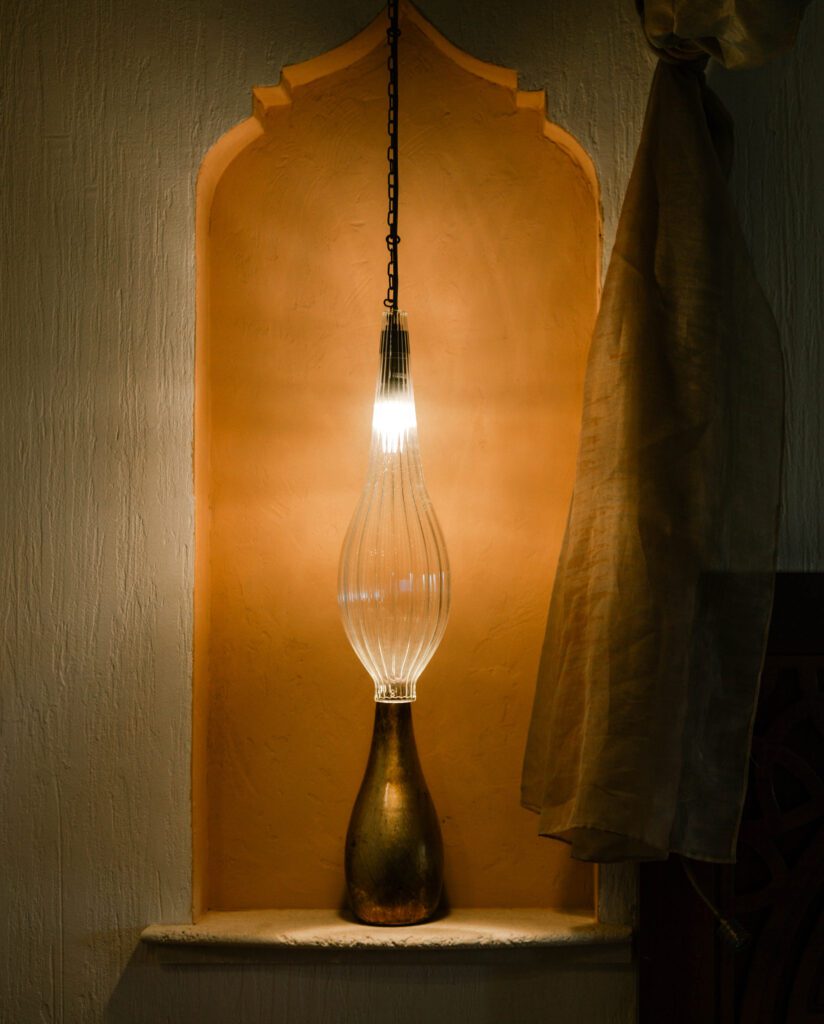
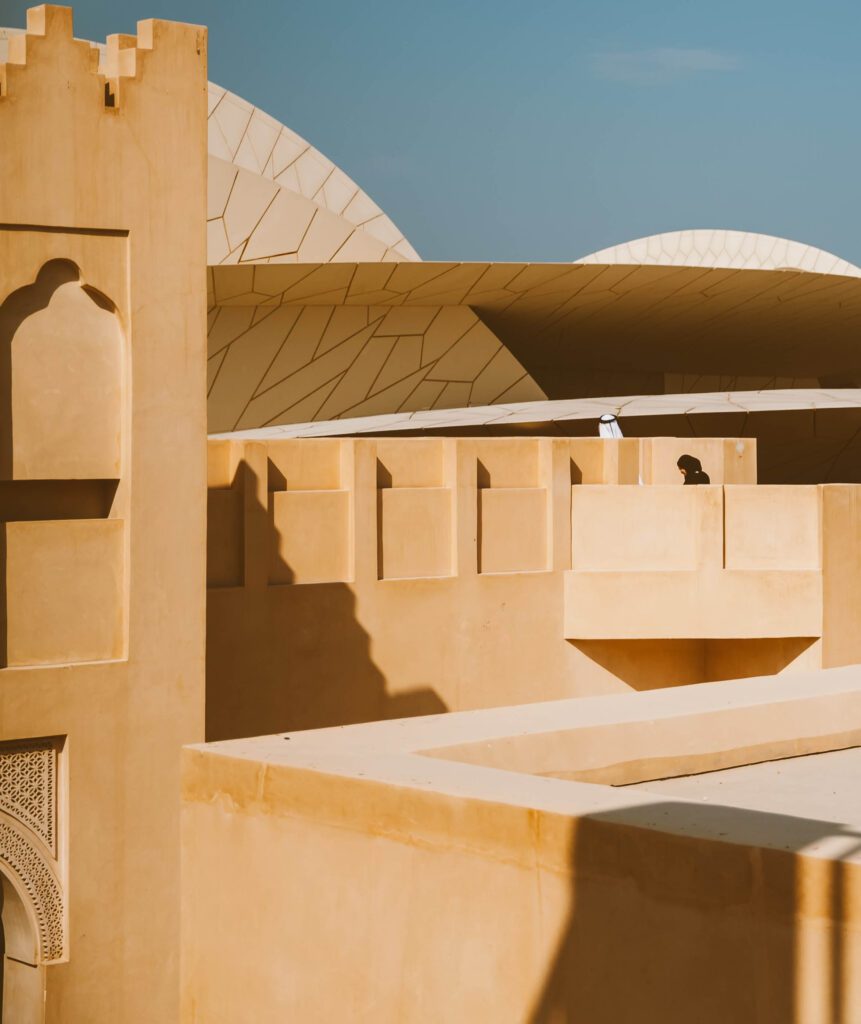
Saad’s shop was filled with these Chinese-cultured pearls, each lustrous and plump, laid out on a piece of white cloth. I could see a near-metallic sheen on their surfaces. In present-day Qatar, pearls have thoroughly replaced porcelain and silk as the starring export from China along this new Silk Road to the Arab world. Given that Qatar was once the Persian Gulf’s largest exporter of natural sea pearls, these pearls in his shop felt as though they had come full circle, returning to their ancestral home. I picked one up absentmindedly and wondered if the wrinkled hands that had nurtured its life might have come from my own hometown—whether it could understand my dialect, just as it once heard the work songs of those who surrounded it at the very beginning.
“Do you have a pearl here that you value the most?”
After hearing my stories of pearl cultivation in my hometown, Saad’s once-detached demeanor turned to one of shared camaraderie and enthusiasm. He hesitated for a moment, then pulled open a drawer. Cupped in his palm lay a perfectly round golden pearl. As a former pearl diver, Saad had a sharp eye for quality. This golden pearl had the fullness and size characteristic of cultured pearls, yet it also carried the gentle glow unique to wild pearls that have spent years soaking in ocean water. I stared in wide-eyed amazement.
Its golden color came from the metal ions in the water where the oyster grew. In my childhood hometown, during the oyster harvest season, finding a single golden pearl would become a topic of conversation for months—something its owner would proudly share at festival banquets. Even though Saad deals daily with the finest cultured pearls, he still keeps these wild pearls from the ocean tucked away in his drawer. They once provided his livelihood in the silent darkness of the sea, defining the earliest memories of his life.
Glancing behind Saad, I noticed a black-and-white photograph of him, half-clothed, that stirred a curious feeling in me. It showed Saad as a young man.
“I was just in my early twenties,” Saad said, following my gaze, a mix of pride and bashfulness in his voice.
In the picture, his eyes gleamed with intensity. His skin was deeply tanned, his muscles toned by constant struggle against the water and rocks while pearl diving. His curly black hair, now hidden beneath a white headdress, suggested that youthful Saad’s fashion statements were few and precious amid the grind of daily labor. After being forced to leave the pearl-diving trade, Saad had worked as a bodybuilder and an actor. The photo before me was from his audition portfolio. He is fluent in Arabic, English, Italian, and Hindi, and he has even written poetry. Although his teenage dream of becoming an actor never materialized, half a century later, Saad became one of Qatar Airways’ brand ambassadors in their promotional films.
“This is the work I’ve loved my whole life,” he said firmly.
I asked if he ever missed his old pearl-diving days.
“I don’t miss the physical exhaustion, but I do miss my companions.”
Contrary to my earlier assumptions that pearl diving might be a solitary pursuit, Saad explained that only with a team’s support could a diver truly ensure his safety.
“You’ve noticed those sailing boats by the waterfront, haven’t you?” He glanced around his small shop as if trying to locate the harbor. “Those are the vessels we used to take out to sea as a group.”
I recalled my walk along the waterfront a short while ago—indeed, in Doha’s old harbor by the pearl sculpture, a row of single-mast dhows was moored. A few tourists had been boarding them, ready to take in Doha’s impressive skyline—an outing I would be doing in the coming days. These days, the single-mast dhows are used only for sightseeing. Yet for me, they represent the romantic and exotic side of Qatar’s rapid development—a way to drift on the tranquil Persian Gulf and reflect on the past from a modern vantage point. But in Saad’s memories, there was nothing romantic about them, only hard labor and life-or-death stakes.
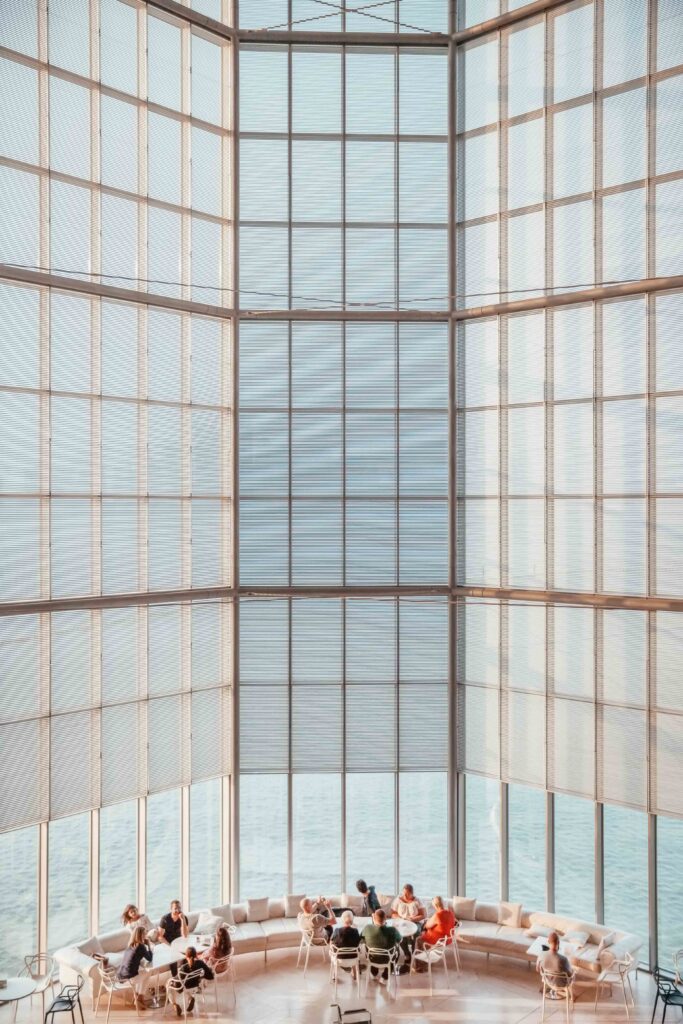
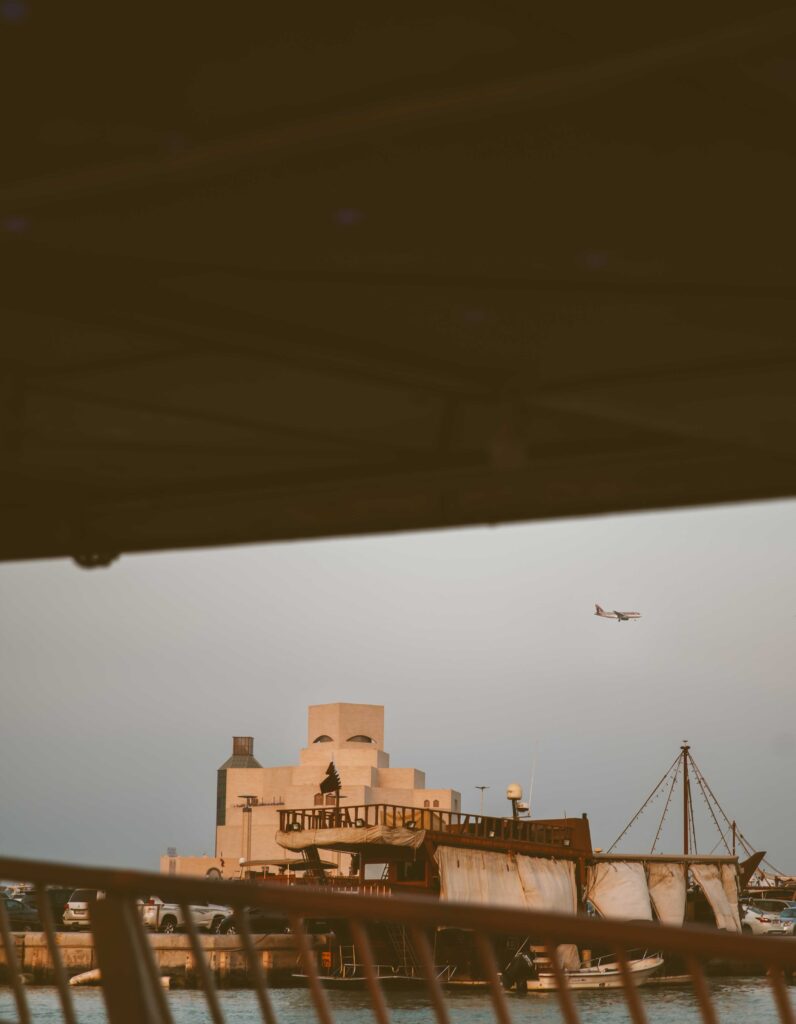
In the past, from June to September, Saad would head out with the fleet to the oyster beds for several weeks at a time. When they departed, people throughout Doha would gather around what is now the old harbor. The men sang, beat drums, and waved flags in spirited farewell, while the women huddled together in prayer, silently repeating the names of their fathers, husbands, and brothers, pleading for their safe return. As Qatar’s only source of income in those days, pearl divers like Saad were revered as heroes in the eyes of every Doha resident. On each dhow, in addition to the captain, divers, and assistants, there were also fishermen and cooks—each with his own clearly defined role. Saad had inherited from his forebears a keen sense for reading currents and water color, skills he relied on to locate oysters amid the vast ocean by day. The Persian Gulf’s slow currents and deep, dark waters demanded enormous patience and perseverance. Once he found a promising spot, Saad would wrap a piece of cloth around his waist, don sheepskin gloves, and tie one end of a thick rope to the boat and the other around his foot. Then, clutching a small rock, he would drop into the water. It was a nearly suicidal method of fishing, as there was no modern diving gear. With the weight of the stone pulling him down about ten meters, he would hold his breath for up to a minute and a half, quickly prying oysters and pearl shells off the rocks with a curved knife and stowing them in a rope bag around his neck. Once finished, he tugged the rope, and the assistant on board would haul him back up for air. The entire process was swift and allowed no margin for error.
Those single-mast dhows bore witness not just to Qatar’s rise but also to the struggles and sacrifices of its ordinary people.
“My favorite part of the pearl-diving season was the night,” Saad said thoughtfully.
When darkness fell, Saad and the other divers would gather on the boat, prying open the day’s oysters by the light of the moon and a flickering oil lamp, searching by feel for pearls. Dive, return, pry open shells, then dive again—this was the rhythm of Saad’s life in the scorching summer. For the young Saad, time out on that endless sea meant nothing; there was all the time in the world.
Father dives to the ocean floor,
To free the pearl’s bright glow,
His palms grow calloused,
His back curved like a sail.
…
Saad sang softly, his voice smooth and resonant. In the long nights of the pearl-diving season, he and his companions, longing for home, composed many of the seafaring ballads still passed down in Qatar. So intertwined is Qatari culture with the sea and pearls that Saad would sing before plunging into the depths, or while chatting and sorting pearls on deck, lifting his voice to the star-filled sky so that the sea breeze might carry word of his safety to his family. When the boat returned to port, the women of his tribe would gather on shore, clapping and singing the same songs about searching for pearls—songs Saad had sung far out at sea.
Once Saad’s fleet arrived back in Doha, the pearls they collected would be turned over to a Bedouin sheikh for safekeeping. On an auspicious day, Arab traders from all around would flock to Souq Waqif, vying to bid on these gems of the deep. Purchased pearls were sorted by color, size, and luster, then sent by Arab caravans to the Mediterranean, India, and China. Before pearl diving in Qatar disappeared entirely, nearly all Persian Gulf pearls were wild, plucked from the sea, and prized as treasures in global trade.
Situated in a corner of the Persian Gulf, Qatar connects the Mesopotamian Plain and the West Indies, bridging the Arabian Sea and the South China Sea. It naturally became an important trading hub of the Persian Gulf along the ancient Maritime Silk Road. In his Records of the Western Oceanic Vassal States, Gong Zhen mentioned many large pearls from the Persian Gulf region. On the merchant ships sailing between the Gulf and East Asia, pearls, silk, porcelain, spices, and jewels were as abundant as the waves on the sea or stars in the sky. Regrettably, though pearls from Qatar likely appeared in the imperial courts of China as early as the Han and Tang dynasties—brought by Arab ships traveling to the South China Sea—they seldom reached ordinary people. So few Persian pearls entered the Chinese market that the populace barely knew of them, leaving scant records. Amid the brilliance of porcelain and spices, Qatar’s pearls often faded into the background.
I knew the few perfectly round ocean pearls Saad showed me were hard-won. One might sift through thousands of oysters—and risk a diver’s life—to find just a handful of such gems. Saad’s voice grew subdued, and I wondered if he was remembering his old diving companions. Perhaps someone among them never returned with the fleet and now rests eternally in the depths of the sea. I could only guess at those stories, never fully knowing.
The Qatari royal family, ever eager to present a positive image to the world, nonetheless allowed the entire nation to mourn for its pearl divers in the grand opening ceremony of the Asian Games. One can only assume that divers lost at sea was once a tragic but frequent occurrence.
Thirteen years later, I finally understood the grief and anger in those black-veiled dancers—an expression of the gentleness and deep sentiment woven into the Qatari psyche. Every time a pearl diver plunged into the sea, he laid another stone in the path of Qatar’s progress. Amid the country’s rapid modernization, they strive to preserve the cultural memory of their ancestors in the ocean through oral histories. Saad, perhaps, stands as a lone sentinel for countless Persian Gulf pearl guardians, keeping watch at the gates of time. And beyond those gates, the sea still surges with freedom, curiosity, and wealth.

